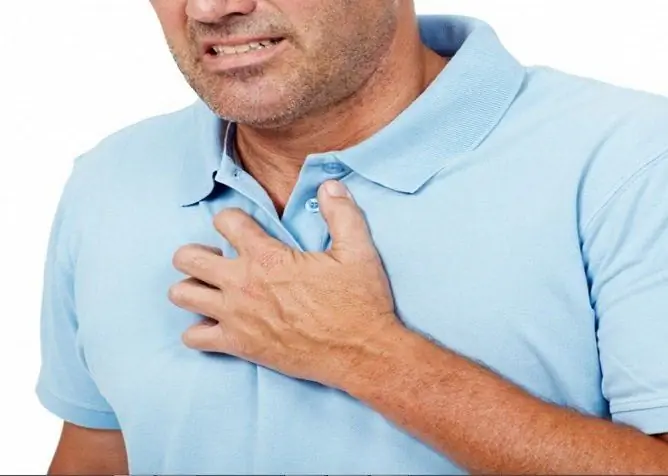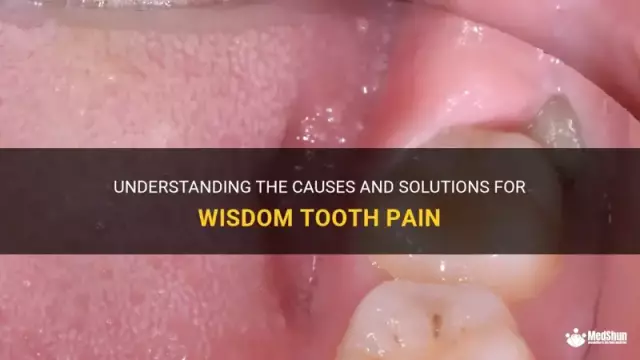- Author Rachel Wainwright [email protected].
- Public 2023-12-15 07:39.
- Last modified 2025-11-02 20:14.
Pinched sciatic nerve
The content of the article:
- Causes of pinched sciatic nerve
- Forms
- Signs of a pinched sciatic nerve
- Diagnostics
- Treating a pinched sciatic nerve
- Possible complications and consequences
- Forecast
- Prevention
Pinching of the sciatic nerve is a pathological condition that develops as a result of compression of the nerve, while the myelin sheath is not damaged. The sciatic nerve is the longest nerve in the human body, it starts in the sacral region and reaches the phalanges of the fingers of the lower extremity and the heel. Contains motor and sensory nerve fibers, innervates the knee and hip joints.

Herniated discs - one of the causes of pinching of the sciatic nerve
Most often, pinching of the sciatic nerve occurs in the area of the piriformis muscle (lumen of the sciatic foramen) or vertebral discs. Pathology is accompanied by pain in the leg. In most cases, the pinching is unilateral, much less often both limbs are involved in the pathological process. The condition can lead to inflammation (radiculitis), complicated by severe pain. More prone to pinching of the sciatic nerve are men engaged in heavy physical work.
Synonyms: sciatica, lumbosacral radiculopathy.
Causes of pinched sciatic nerve
Pinching of the sciatic nerve often occurs during the performance of any activity that requires sudden movements, as a result of prolonged stay in an uncomfortable position, limitation of motor activity, excessive load on the lumbar spine.
Often, pinching is formed against the background of other pathologies, which include:
- herniated intervertebral discs;
- spinal injury with displacement of the vertebrae;
- an abscess or neoplasm in the sciatic nerve;
- osteochondrosis of the lumbosacral spine;
- displacement of the structures of the spine (spondylolisthesis);
- inflammatory diseases of the pelvic organs;
- gout;
- sepsis;
- diabetes;
- multiple sclerosis;
- infections (most often influenza, whooping cough, rubella, bone tuberculosis, malaria);
- blood clots;
- acute intoxication;
- hypothermia.
In addition, muscle spasms along the sciatic nerve may be the cause.
The sciatic nerve in women is often impaired during pregnancy due to the pressure of the enlarged uterus on adjacent organs and an increase in the load on the spine due to the shift in the center of gravity of the body, as well as in cases where a pregnant woman takes an uncomfortable body position. Another period of increased risk of symptoms of a pinched sciatic nerve in women is menopause, due to changes in hormonal levels.

Pregnancy can pinch the sciatic nerve
Risk factors include:
- poisoning with alcohol, heavy metals, neurotropic toxic substances;
- smoking;
- herpes zoster in the projection of the sciatic nerve;
- overweight;
- deficiency of minerals in the body.
Forms
Depending on the severity, there are three forms of pinching of the sciatic nerve:
- easy;
- moderate;
- heavy.
Severe pinching of the sciatic nerve can be accompanied by signs of spinal cord injury and immobilization of the patient.
Signs of a pinched sciatic nerve
Pain syndrome is the most typical manifestation of a pinched sciatic nerve. The pain is of a different nature (sharp, aching, shooting, throbbing, pulling). As a rule, painful sensations are noted in the lumbar region, buttocks; along the back of the thigh, the pain descends to the lower leg and heel, radiates to the fingers of the lower extremity. Sometimes there is numbness along the nerve, as well as burning and / or tingling of the skin. The pain can increase in a sitting position, when coughing, laughing, muscle tension, etc. In addition to pain, difficulties arise when walking, standing for a long time, and lameness may develop (on one leg with unilateral pinching or on both legs with bilateral pinching).

Pain syndrome is the main symptom of a pinched sciatic nerve
In men, the signs of pinching may mimic those of prostatitis. Symptoms of a pinched sciatic nerve in women vary depending on the cause and extent of the injury. It is noted that women often have no discomfort in the lower back.
The most common symptoms of a pinched sciatic nerve include:
- muscle atrophy and muscle weakness;
- sensitivity disorders (increase or decrease);
- dry skin;
- the appearance of pathological reflexes;
- feeling of creeping creeps;
- increased sweating of the feet;
- limiting leg / leg movement.
Diagnostics
Diagnosis of a pinched sciatic nerve is usually not difficult due to the specific clinical picture. As a rule, the diagnosis is made during an objective examination of the patient, collection of complaints and anamnesis. However, in order to avoid relapses, it is necessary to determine the factors that contributed to the pinching of the sciatic nerve.
To determine the cause of the development of the pathological process, the following instrumental and laboratory diagnostic methods are used:
- X-ray examination of the lumbar region and pelvis;
- magnetic resonance imaging or computed tomography of the lumbar region;
- Ultrasound;
- electroneuromyography;
- radioisotope scanning of the spine (in case of suspected neoplasms);
- general and biochemical blood test;
- general urine analysis; and etc.

Diagnosis of a pinched sciatic nerve includes x-rays of the lumbar region and pelvis
A study of reflexes is carried out, the presence of Bonnet's symptom, Lasegue's symptom, a decrease in plantar, Achilles and knee reflexes is determined, and sensitivity is assessed on the affected side.
Differential diagnosis with a herniated disc is required. A hernia is characterized by a longer development of the pathological process, as well as relapses of neuralgic manifestations.
Treating a pinched sciatic nerve
The traditional treatment for a pinched sciatic nerve is a combination of drug therapy and physiotherapy. In some cases, surgery is required.
In the event of a pinched sciatic nerve, hospitalization of the patient is not necessary. Subject to patient compliance with the doctor's prescriptions, treatment can be carried out at home. In case of acute pain that prevents the patient from walking and / or being in an upright position for a long time, bed rest is shown for a period of several days to a week. Due to the need for a fixed body position during acute pain, it is recommended to use a hard mattress.
In the treatment of sciatic nerve entrapment, the drugs of choice are non-steroidal anti-inflammatory drugs, which are administered by intramuscular injection or orally (capsules or tablets). With the oral route of administration of non-steroidal anti-inflammatory drugs, there is a risk of developing gastritis and / or peptic ulcer disease, therefore, the appointment of proton pump inhibitors is indicated.
When the sciatic nerve is pinched due to muscle spasms, the therapeutic effect is achieved by using drugs that improve blood circulation (venotonics). With severe muscle spasms, antispasmodics and / or muscle relaxants are prescribed. In addition, the appointment of vitamin complexes, as well as drugs that improve metabolism, is shown.
General therapy is complemented by local - anti-inflammatory and warming agents are used in the form of an ointment or gel.
Physiotherapy methods are also prescribed to complement the effect of drugs. These methods include:
- electro-, phonophoresis of medicinal substances;
- UHF therapy;
- magnetotherapy;
- paraffin applications;
- laser therapy;
- mud therapy;
- hydrogen sulphide, radon baths;
- hirudotherapy;
- ultraviolet irradiation of the affected area.
Acupuncture and acupressure can be used, as well as manual therapy (the appointment should be approached with caution, in some cases it is not recommended).

Mud therapy can be included in the complex treatment of pinched sciatic nerve
In the rehabilitation period, physical therapy, swimming, yoga, Pilates provide a good effect, however, these methods can be used only if the patient is in a satisfactory condition and does not have acute pain. In the period of remission, the patients are shown sanatorium treatment.
Possible complications and consequences
Pinching of the sciatic nerve can be complicated by the following conditions:
- intense pain syndrome;
- disruption of the internal organs;
- sleep disorders;
- decreased libido;
- menstrual irregularities in women;
- infertility;
- exacerbation of chronic diseases;
- violations of the evacuation function of the intestines and bladder;
- a sharp decrease in motor activity, up to immobilization.
Forecast
With timely adequate therapy for pinching the sciatic nerve, the changes caused by it are completely reversible, the prognosis is favorable.
Prevention
In order to prevent pinching of the sciatic nerve, it is recommended:
- adjust body weight when overweight;
- avoid carrying weights, lift the load only with correct weight distribution and with a straight back;
- control posture;
- periodically resort to general massage;
- sleep on a surface of moderate hardness.
In order to prevent the occurrence of relapses and complications, patients with a pinched sciatic nerve are recommended:
- balanced balanced nutrition;
- avoid prolonged sitting, especially on soft chairs;
- avoid sharp turns of the body, bends;
- avoid hypothermia, especially the lumbar region.
YouTube video related to the article:

Anna Aksenova Medical journalist About the author
Education: 2004-2007 "First Kiev Medical College" specialty "Laboratory Diagnostics".
The information is generalized and provided for informational purposes only. At the first sign of illness, see your doctor. Self-medication is hazardous to health!






